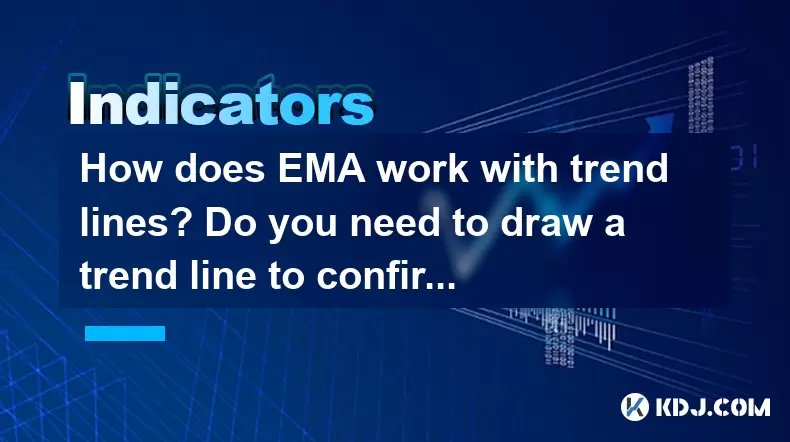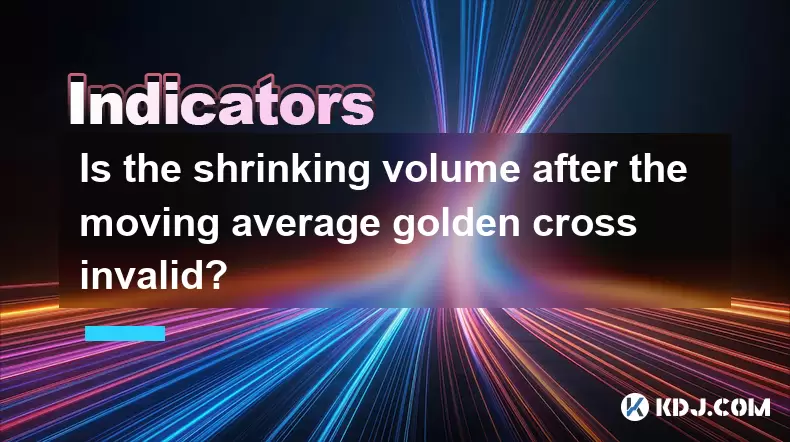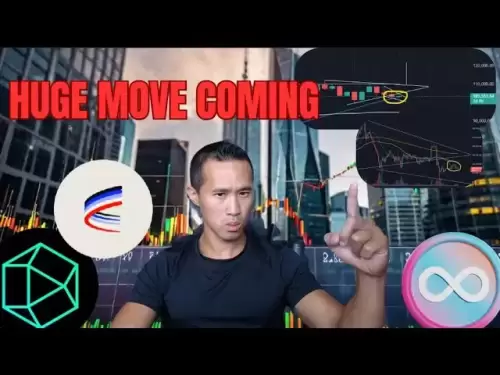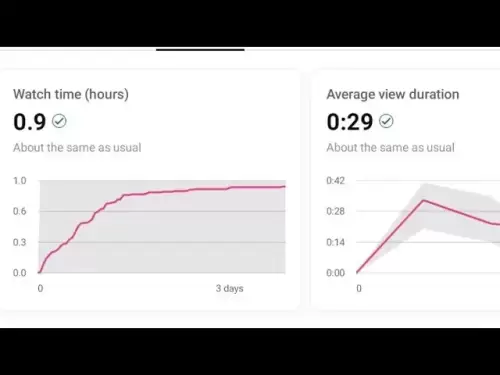-
 Bitcoin
Bitcoin $103,456.1111
0.49% -
 Ethereum
Ethereum $2,414.9631
0.02% -
 Tether USDt
Tether USDt $1.0006
0.05% -
 XRP
XRP $2.1083
0.24% -
 BNB
BNB $634.8760
-0.76% -
 Solana
Solana $139.8437
1.94% -
 USDC
USDC $0.9998
-0.01% -
 TRON
TRON $0.2737
0.97% -
 Dogecoin
Dogecoin $0.1602
0.20% -
 Cardano
Cardano $0.5737
1.08% -
 Hyperliquid
Hyperliquid $32.9779
-2.54% -
 Bitcoin Cash
Bitcoin Cash $474.8886
-1.80% -
 Sui
Sui $2.6272
-1.99% -
 Chainlink
Chainlink $12.4878
0.14% -
 UNUS SED LEO
UNUS SED LEO $8.9234
0.35% -
 Stellar
Stellar $0.2411
-0.18% -
 Avalanche
Avalanche $17.0274
-0.70% -
 Toncoin
Toncoin $2.8936
-1.11% -
 Shiba Inu
Shiba Inu $0.0...01112
-0.58% -
 Litecoin
Litecoin $82.6982
1.33% -
 Hedera
Hedera $0.1423
-0.05% -
 Monero
Monero $314.8455
3.26% -
 Ethena USDe
Ethena USDe $1.0006
0.01% -
 Polkadot
Polkadot $3.4043
1.14% -
 Dai
Dai $0.9999
0.01% -
 Bitget Token
Bitget Token $4.2848
-0.13% -
 Uniswap
Uniswap $6.8748
-5.45% -
 Pepe
Pepe $0.0...09661
0.52% -
 Pi
Pi $0.5359
1.19% -
 Aave
Aave $242.9168
-1.03%
How does EMA work with trend lines? Do you need to draw a trend line to confirm after the moving average breaks?
EMA, calculated with a formula emphasizing recent prices, and trend lines, drawn to connect price points, help traders analyze crypto market trends and make informed decisions.
May 27, 2025 at 11:49 pm

Introduction to EMA and Trend Lines
The Exponential Moving Average (EMA) and trend lines are two fundamental tools used by traders in the cryptocurrency market to analyze price movements and make informed trading decisions. EMA is a type of moving average that places a greater weight and significance on the most recent data points, making it more responsive to new information compared to the Simple Moving Average (SMA). Trend lines, on the other hand, are straight lines drawn on a chart to connect a series of prices to identify the direction of the trend.
Understanding EMA
The Exponential Moving Average is calculated using a specific formula that gives more weight to recent prices. The formula for EMA is as follows:
[ \text{EMA}{\text{today}} = (\text{Price}{\text{today}} \times \text{Multiplier}) + (\text{EMA}_{\text{yesterday}} \times (1 - \text{Multiplier})) ]
Where the Multiplier is calculated as:
[ \text{Multiplier} = \frac{2}{\text{Number of Periods} + 1} ]
For example, a 20-day EMA would use a multiplier of 2/(20+1) = 0.0952. This means that the current price has a 9.52% influence on the EMA, while the previous EMA value contributes the remaining 90.48%.
Drawing Trend Lines
Trend lines are drawn by connecting at least two significant highs or lows on a price chart. Uptrend lines are drawn along the lows, indicating potential support levels, while downtrend lines are drawn along the highs, indicating potential resistance levels. To draw a valid trend line, it is essential to follow these steps:
- Identify two or more significant lows for an uptrend or highs for a downtrend.
- Use a drawing tool on your charting platform to connect these points.
- Ensure the line is straight and touches the most significant points without intersecting the price bars or candles.
EMA and Trend Line Interaction
The interaction between EMA and trend lines can provide valuable insights into market trends and potential reversal points. When the price is above the EMA and an uptrend line, it suggests a strong bullish trend. Conversely, when the price is below the EMA and a downtrend line, it indicates a strong bearish trend.
Using EMA Breaks to Confirm Trend Lines
One common strategy traders use is to wait for the EMA to break through a trend line to confirm a potential trend change. Here's how this process works:
- Identify the Trend Line: Draw a trend line based on recent price action.
- Monitor the EMA: Keep an eye on the EMA, particularly if it is approaching the trend line.
- EMA Breakthrough: If the EMA crosses the trend line, it may signal a potential change in the trend.
For example, if the price is in an uptrend and the 20-day EMA breaks below the uptrend line, it could indicate that the bullish momentum is weakening, and a bearish reversal might be imminent.
Do You Need to Draw a Trend Line to Confirm After the Moving Average Breaks?
While it is not strictly necessary to draw a trend line to confirm an EMA break, doing so can provide additional confirmation and clarity. Here's why:
- Visual Confirmation: A trend line provides a visual representation of the trend, making it easier to see when the EMA breaks through.
- Additional Data Points: Trend lines use multiple price points, offering more data for analysis compared to the EMA alone.
- Enhanced Decision Making: Combining the EMA break with a trend line break can enhance the reliability of your trading signals.
However, some traders may rely solely on the EMA break without drawing a trend line. This approach can be effective, especially in fast-moving markets where quick decisions are necessary. The key is to find a method that aligns with your trading style and risk tolerance.
Practical Example of EMA and Trend Line Interaction
Let's consider a practical example using Bitcoin (BTC) to illustrate how EMA and trend lines can be used together:
- Step 1: Open a charting platform and select a BTC/USD chart with a 1-hour timeframe.
- Step 2: Calculate and plot a 20-day EMA on the chart.
- Step 3: Identify recent lows and draw an uptrend line connecting these points.
- Step 4: Observe the price action and EMA. If the price is consistently above the EMA and the uptrend line, it suggests a strong bullish trend.
- Step 5: Monitor for a potential break. If the EMA breaks below the uptrend line, it might signal a trend reversal.
- Step 6: Confirm the break by observing subsequent price action. If the price continues to move lower and stays below the EMA, it reinforces the bearish signal.
Using EMA and Trend Lines in Different Timeframes
The effectiveness of EMA and trend lines can vary depending on the timeframe used. Short-term traders might use a 9-day or 12-day EMA on a 15-minute or 1-hour chart to capture quick price movements. Long-term investors may prefer a 50-day or 200-day EMA on a daily or weekly chart to identify broader trends.
- Short-term Chart: A 9-day EMA on a 15-minute chart can help identify short-term trends and potential entry/exit points.
- Medium-term Chart: A 20-day EMA on a 1-hour chart can provide a balance between responsiveness and reliability.
- Long-term Chart: A 50-day or 200-day EMA on a daily chart can help identify major trend changes and long-term investment opportunities.
Combining EMA and Trend Lines with Other Indicators
While EMA and trend lines are powerful tools on their own, combining them with other technical indicators can enhance your analysis. Some popular indicators to consider include:
- Relative Strength Index (RSI): Helps identify overbought or oversold conditions.
- MACD (Moving Average Convergence Divergence): Provides additional trend confirmation and momentum signals.
- Bollinger Bands: Can help identify volatility and potential breakouts.
For example, if the EMA breaks below a trend line and the RSI is also showing overbought conditions, it might strengthen the bearish signal, prompting a trader to consider a short position.
FAQs
1. Can EMA and trend lines be used for all cryptocurrencies?
Yes, EMA and trend lines can be applied to any cryptocurrency. However, the effectiveness may vary depending on the liquidity and volatility of the specific cryptocurrency. More liquid assets like Bitcoin and Ethereum may provide clearer signals compared to less liquid altcoins.
2. How do I choose the right timeframe for my trading strategy?
The choice of timeframe depends on your trading style. Short-term traders might use 1-minute to 1-hour charts, while swing traders might prefer 4-hour to daily charts. Long-term investors often use weekly or monthly charts. Experiment with different timeframes to find what works best for your strategy.
3. Is it better to use EMA or SMA with trend lines?
EMA is generally preferred over SMA when used with trend lines because it reacts more quickly to recent price changes. However, some traders may find that SMA provides more stable signals in certain market conditions. It's important to test both and see which aligns better with your trading goals.
4. Can trend lines be used without any moving averages?
Yes, trend lines can be used independently of moving averages. They provide a clear visual representation of the trend and can be effective in identifying support and resistance levels. However, combining trend lines with moving averages like EMA can enhance the reliability of your analysis by providing additional confirmation signals.
Disclaimer:info@kdj.com
The information provided is not trading advice. kdj.com does not assume any responsibility for any investments made based on the information provided in this article. Cryptocurrencies are highly volatile and it is highly recommended that you invest with caution after thorough research!
If you believe that the content used on this website infringes your copyright, please contact us immediately (info@kdj.com) and we will delete it promptly.
- Ruvi AI: The Audited Token Poised to Outshine Shiba Inu
- 2025-06-22 10:25:12
- Dypians, DeFi, and Sei Network: A Deep Dive into the Latest Trends
- 2025-06-22 10:25:12
- Hacken Security Breach Highlights Risks Across Ethereum and BSC
- 2025-06-22 08:25:12
- SHIB Price, Forecasts, Timelines: Will Shiba Inu Ever Reach the 'One-Cent Dream'?
- 2025-06-22 08:25:12
- Avalanche vs. Ruvi AI: Why Smart Money's on This Audited Token
- 2025-06-22 08:45:12
- Bitcoin Demand on Pause: What's Next for the Crypto King?
- 2025-06-22 08:45:12
Related knowledge

Does the second surge in the RSI overbought zone induce more?
Jun 22,2025 at 08:35am
Understanding the RSI Overbought ZoneThe Relative Strength Index (RSI) is a momentum oscillator commonly used in technical analysis to measure the speed and change of price movements. It ranges from 0 to 100, with values above 70 typically considered overbought and values below 30 considered oversold. When the RSI enters the overbought zone for the firs...

Does the sudden contraction of ATR indicate the end of the trend?
Jun 20,2025 at 11:14pm
Understanding ATR and Its Role in Technical AnalysisThe Average True Range (ATR) is a technical indicator used to measure market volatility. Developed by J. Welles Wilder, ATR calculates the average range of price movement over a specified period, typically 14 periods. It does not indicate direction—only volatility. Traders use ATR to gauge how much an ...

Is it invalid if the DMI crosses but the ADX does not expand?
Jun 21,2025 at 09:35am
Understanding the DMI and ADX RelationshipIn technical analysis, the Directional Movement Index (DMI) consists of two lines: +DI (Positive Directional Indicator) and -DI (Negative Directional Indicator). These indicators are used to determine the direction of a trend. When +DI crosses above -DI, it is often interpreted as a bullish signal, while the opp...

How to filter false signals when the SAR indicator frequently flips?
Jun 21,2025 at 08:43pm
Understanding the SAR Indicator and Its BehaviorThe SAR (Stop and Reverse) indicator is a popular technical analysis tool used in cryptocurrency trading to identify potential reversals in price movement. It appears as a series of dots placed either above or below the price chart, signaling bullish or bearish trends. When the dots are below the price, it...

Is the trend continuation when the Williams indicator is oversold but there is no rebound?
Jun 20,2025 at 11:42pm
Understanding the Williams %R IndicatorThe Williams %R indicator, also known as the Williams Percent Range, is a momentum oscillator used in technical analysis to identify overbought and oversold levels in price movements. It typically ranges from 0 to -100, where values above -20 are considered overbought and values below -80 are considered oversold. T...

Is the shrinking volume after the moving average golden cross invalid?
Jun 22,2025 at 10:42am
Understanding the Moving Average Golden Cross in CryptocurrencyIn the world of cryptocurrency trading, technical indicators play a crucial role in decision-making. One such indicator is the moving average golden cross, which occurs when a short-term moving average crosses above a long-term moving average, typically signaling a bullish trend. This event ...

Does the second surge in the RSI overbought zone induce more?
Jun 22,2025 at 08:35am
Understanding the RSI Overbought ZoneThe Relative Strength Index (RSI) is a momentum oscillator commonly used in technical analysis to measure the speed and change of price movements. It ranges from 0 to 100, with values above 70 typically considered overbought and values below 30 considered oversold. When the RSI enters the overbought zone for the firs...

Does the sudden contraction of ATR indicate the end of the trend?
Jun 20,2025 at 11:14pm
Understanding ATR and Its Role in Technical AnalysisThe Average True Range (ATR) is a technical indicator used to measure market volatility. Developed by J. Welles Wilder, ATR calculates the average range of price movement over a specified period, typically 14 periods. It does not indicate direction—only volatility. Traders use ATR to gauge how much an ...

Is it invalid if the DMI crosses but the ADX does not expand?
Jun 21,2025 at 09:35am
Understanding the DMI and ADX RelationshipIn technical analysis, the Directional Movement Index (DMI) consists of two lines: +DI (Positive Directional Indicator) and -DI (Negative Directional Indicator). These indicators are used to determine the direction of a trend. When +DI crosses above -DI, it is often interpreted as a bullish signal, while the opp...

How to filter false signals when the SAR indicator frequently flips?
Jun 21,2025 at 08:43pm
Understanding the SAR Indicator and Its BehaviorThe SAR (Stop and Reverse) indicator is a popular technical analysis tool used in cryptocurrency trading to identify potential reversals in price movement. It appears as a series of dots placed either above or below the price chart, signaling bullish or bearish trends. When the dots are below the price, it...

Is the trend continuation when the Williams indicator is oversold but there is no rebound?
Jun 20,2025 at 11:42pm
Understanding the Williams %R IndicatorThe Williams %R indicator, also known as the Williams Percent Range, is a momentum oscillator used in technical analysis to identify overbought and oversold levels in price movements. It typically ranges from 0 to -100, where values above -20 are considered overbought and values below -80 are considered oversold. T...

Is the shrinking volume after the moving average golden cross invalid?
Jun 22,2025 at 10:42am
Understanding the Moving Average Golden Cross in CryptocurrencyIn the world of cryptocurrency trading, technical indicators play a crucial role in decision-making. One such indicator is the moving average golden cross, which occurs when a short-term moving average crosses above a long-term moving average, typically signaling a bullish trend. This event ...
See all articles
























































































